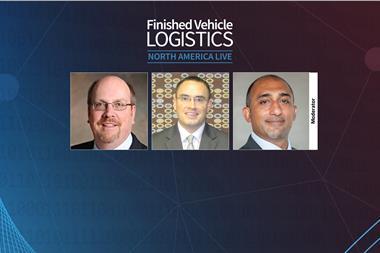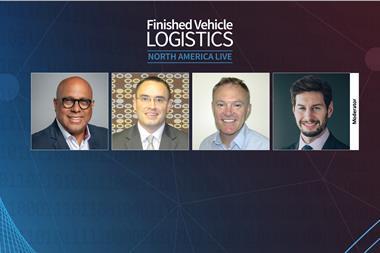Volkswagen has been exporting volumes of its ID.4 battery electric SUV to the US from its assembly plant in Zwickau, Germany since March 2021. By the end of May this year it had moved 8,300 of the vehicles across the Atlantic. Significantly for vehicle logistics, VW has set out to make the method of delivery as sustainable as the vehicle it is delivering.

The carmaker has committed that the manufacture and delivery of the electric ID series will be carbon neutral, including for its supply chain and logistics. That is also part of the carmaker’s ‘goTOzero impact logistics’ strategy, which is focused on green rail transport (in Germany) and the use of car carrier ocean vessels fuelled by liquified natural gas (LNG) for overseas deliveries.
VW is moving the ID.4s from Zwickau by rail to the port of Emden, which is dedicated to VW vehicle processing for export. As part of the goTOzero strategy, VW Group aims to switch all of the vehicles it moves in Germany with state-run rail provider Deutsche Bahn (DB) to ‘green electricity’ by the end of this year. That also goes for parts and materials, and as has been reported elsewhere, the lifecycle of the ID.4 is conforms to this strategy in that battery modules and battery systems for the ID.4 are delivered into the Braunschweig and Zwickau plants by rail.
“In Germany and Austria, we have already switched our rail transport, including material and vehicles, completely to green electricity with the main German transport company DB Cargo,” confirmed a spokesperson for VW Group Logistics.
By green electricity VW means power generated by wind farms and hydropower plants. Furthermore, the carmaker said last year that it intends to increase the number of vehicles it moves by rail in Germany to 60% by 2022, an 8% increase on the number currently moved.
“The task [of goTOzero] is to minimise environmental impacts [and] in logistics we proceed according to the action premises of avoid, reduce, convert and compensate,” said a spokesperson for the carmaker. “The LNG ships and rail transports, powered as much as possible by electricity generated from renewable sources, are important measures in this regard.”
LNG car carriers
At the port of Emden, the ID.4 EVs are loaded onto car carrier vessels along with other VW Group models (including other battery electric and plug-in hybrid models). VW is using nine vessels in total on the North Atlantic route as part of its the weekly in-house charter ship service.

Currently, that includes two LNG vessels chartered from Siem Car Carriers – the Siem Confucius and Siem Aristotle, each with capacity for 4,800 vehicle units. They deliver ID.4s to the US ports of Davisville (Rhode Island), Baltimore (Maryland) and Jacksonville (Florida) on the east coast, and Houston (Texas) on the Gulf coast. VW is also looking to confirm two ports on the west coast of the US.
It takes 27 days for the vehicles to reach the first US port from when they leave the factory in Zwickau. On arrival in the US the ID.4 is handled from a processing standpoint like any other vehicle being delivered alongside it, both EV and those driven by convention internal combustion engine (ICE).
“We have several other BEV [battery EV] and PHEV [plug-in hybrid] vehicles in the VW Group of America [VWGoA] family,” said a spokesperson for the carmaker’s US division. “With some differentiation in handling for battery charging requirements, these cars are released to carriers for dealer delivery with our ICE [internal combustion engine] vehicles.”
VWGoA is working at eight locations in the US for these services and terminal operations are provided by Amports, Mid-Texas International, Norad, Pasha and Wallenius Wilhelmsen.
Multimodal strategy
VWGoA does not have the same set up for green rail transport in the US but said it is committed to an optimised multimodal delivery service combining rail and truck, and that includes accommodating for the weight of the heavier electric SUV.
“The ID.4 is shipped by both rail and truck,” said VWGoA. “We’ve seen no weight-related issues on the rail side [and] with proper load planning and product mix. While heavier, the ID.4 has not made a significant impact to load factor [on the road].”
The carmaker works with 25 contracted road haulage partners in the US and meets them regularly to discuss sustainability and environmental targets, according to the carmaker.
“We continue to have discussions with our carrier partners about developing efficient, safe and cost-effective solutions that put alternative fuelling measures into effect for our vehicle deliveries,” said the Volkswagen spokesperson in the US.
Outbound transport planning is carried for VW and Audi brand vehicles in the US by the vehicle logistics team in Reston, Virginia (and there are similar teams in Canada and Mexico).
Looking ahead to the future of EV developments in the US, VW said it was encouraged by the Biden Administration’s support for EVs and that it applauded the efforts being made in government to alleviate battery and semiconductor shortages.
“The Administration must ensure EV policies support, rather than bifurcate, the market so that the US remains an e-mobility leader,” said the spokesperson for VWGoA. “Only policies that build a strong, fair and complete EV marketplace will accelerate consumer adoption and create the domestic centres of gravity needed to pull EV innovation and manufacturing into the US.”
VWGoA intends to start production of the ID.4 at its plant in Chattanooga, Tennessee from 2022.

























![Global[1]](https://d3n5uof8vony13.cloudfront.net/Pictures/web/a/d/s/global1_726550.svgz)













No comments yet